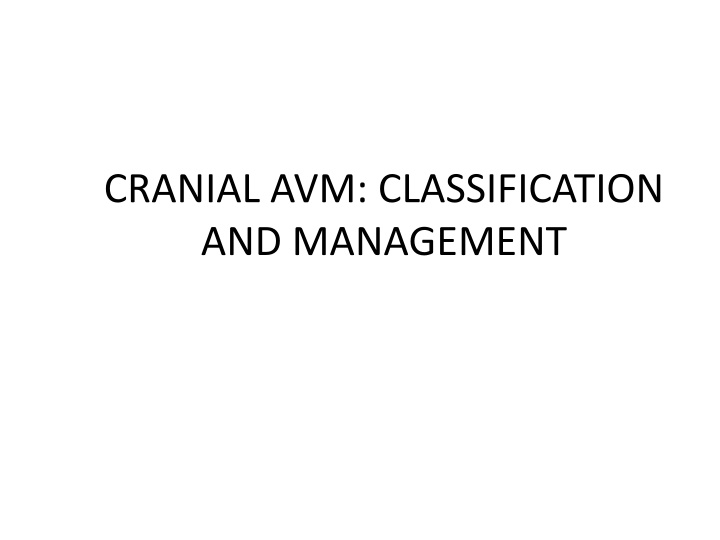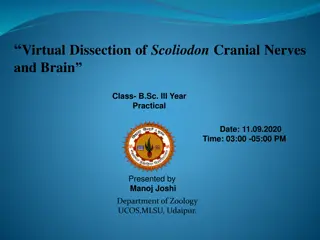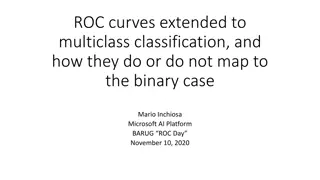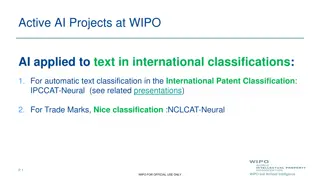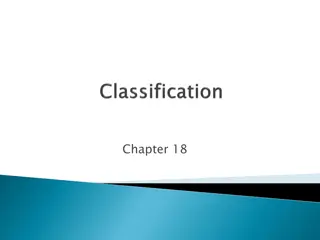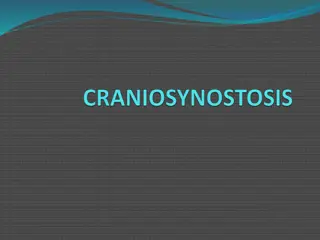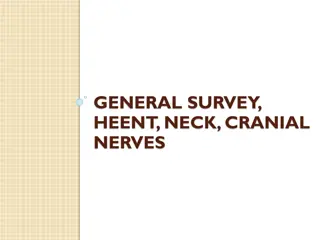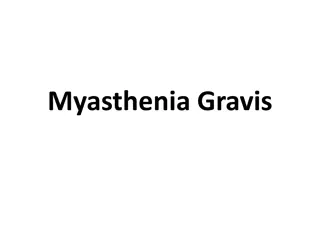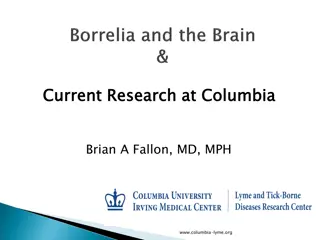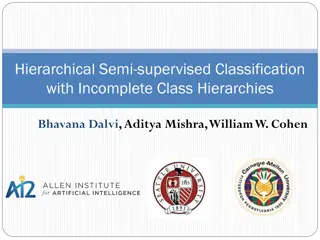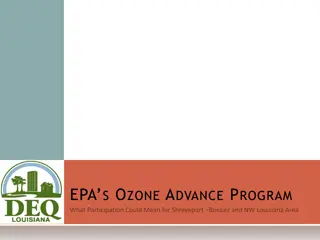CRANIAL AVM: CLASSIFICATION AND MANAGEMENT
This article delves into the classification and management of cranial arteriovenous malformations (AVMs). It explores the various types of AVMs found in the cranial region and discusses different approaches to their treatment. The content provides insights into the complexities of diagnosing and addressing these abnormalities, offering valuable information for healthcare professionals and individuals dealing with such conditions.
Download Presentation

Please find below an Image/Link to download the presentation.
The content on the website is provided AS IS for your information and personal use only. It may not be sold, licensed, or shared on other websites without obtaining consent from the author.If you encounter any issues during the download, it is possible that the publisher has removed the file from their server.
You are allowed to download the files provided on this website for personal or commercial use, subject to the condition that they are used lawfully. All files are the property of their respective owners.
The content on the website is provided AS IS for your information and personal use only. It may not be sold, licensed, or shared on other websites without obtaining consent from the author.
E N D
Presentation Transcript
CRANIAL AVM: CLASSIFICATION AND MANAGEMENT
AV malformations High flow cerebrovascular lesions Prevalence 0.04-0.52% Sporadic (98%) Syndromic (2%) Hereditary hemorrhagic telengiectasia (Osler Weber Rendu) Cerebrofacial AV metameric syndromes (CAMS)
Morphologic features Feeding arteries En passage Terminal Dysplastic vascular nidus Draining vein Perinidal capillary network
CLASSIFICATION FOR CNS VASCULAR ANOMALIES Proliferating vascular tumor Hemangioma Non proliferating vascular malformations Capillary malformation Venous malformation Cavernous malformation Arterial malformation (no shunting) Angiodysplasia Aneurysms AV shunting malformations Classic cerebral AVM Pial dural AVF Carotid cavernous fistula Dural AVF Galenic AVM Mixed malformations Venous - cavernous AVM - venous Cavernous AVM Syndromic CNS malformations
Natural history Incidence 1.4-4.3% (autopsy study) 2% strokes, 38% ICH in 15-45 years Higher in Asians Majority supratentorial (infratentorial commoner in children) 3-30% occur in children Familial present early M = F or slight male preponderance 99% solitary Triangular with base towards the meninges Spontaneous regression 2-3%
AVM Angiogenesis Vascular event with thrombosis Venous hypertension --- HIF1 release VEGF stimulation ---- focal angiogenesis VEGF also released by (leucocyte, macrophages and MMP9 mediated from ECM) Angiogenesis causes IL 6 ---- recruitment of monocyte /macrophages Genetic alteration of TGF , Ang/ Tie-2 signaling Semin Cerebrovasc Dis Stroke. 2004;4:217-225.
Genetics HHT (Osler Weber Rendu) Type I : 9q .ENG gene mutation (TGF III receptor) Type II : 12q. ACVRL 1 gene mutation (TGF I receptor) Type III: 5q. 20% unclassified CAMS (craniofacial AV metameric syndromes) CAMS 1 : hypothalamus/ hypophysis and nose CAMS 2 : occipital lobe, thalamus and maxilla CAMS 3 : cerebellum, pons and mandible Wyburn- Mason : diencephalon/ optic path or midbrain/ thalamus and retina VEGF R1 and 2 over expression Increased Ang-2 expression causing exposure of endothelial cells to VEGF and other growth factors Matrix Metalloproteases
Presentation Asymptomatic Haemorrhage Seizures Headache Neurological defecits Congestive heart failure
Asymptomatic Exact incidence unknown Population based studies of people with intracranial vascular malformations 40% Clinical studies - 2-4% detected incidentally Autopsy based studies only 12% were symptomatic
Haemorrhage Commonest presentation 38-65% Peak in the 5th decade 15% mortality, 30 50% disabling deficit / bleed Parrenchymal > IVH > SAH Risk of bleed 2-4%/ year Lifetime risk of bleed 1-(risk of bleed)n n=number of years of expected life remaining 105-age (assuming a 3% risk of bleed /year) Risk factors Previous bleed Deep location Deep venous drainage Single draining vein Size <3 / >6 cm
AVM and Aneurysms 8-10% (2.7-34%) M (41Y) > F (31Y) Multiple in 30-50% Classification Flow related (85%) Proximal (circle of Willis, proximal feeding vessel till primary bifurcation) Distal Intranidal Unrelated (15%) Mechanisms Incidental Haemodynamic changes due to AVM Both are congenital malformations
Seizures 15-35% Usually focal Increased incidence in Superficial Large size Frontal / Temporal Probable causes Mass effect Cortical irritation Steal ---- ischemia, cortical damage
Headache Seen in 15% at presentation Hemicranial / migraine like Occipital AVM Meningeal artery --- involvement/ recruitment of blood supply from it
Neurological deficits < 10% at presentation Transient, permanent, progressive Learning disorders in 66% of adults Functional decline 1.5%/ Yr (not due to bleed) Mechanism Recurrent bleed Mass effect Hydrocephalus Ischemia Steal phenomenon
CRAWFOR D DA GRAF ONDRA BROWN BROWN APSIMON HALIM COSTA 166 Number of patients 191 217 160 91 57 678 760 unruptured 4.8 yr for unruptured Average follow-up 10.4 yr 23.7 yr 8.2 yr 6.6 yr 10 yr 2.85 yr 3.9 yr Annual risk for hemorrhage 4% 4.61% Mortality from hemorrhage population studied 8.3% 23% 24.6% Proportion with hemorrhage experiencing morbidity-mortality from hemorrhage 13% 20% (40%) 29% (45%) Annual risk for death by hemorrhage 1.0% Morbidity and mortality from hemorrhage for the population studied 34% Annual morbidity and mortality 2.7% 14% at 5 yr, 39% 20 yr (2%-3%/yr) Annual risk for hemorrhage in the absence of a hemorrhagic history 1.7% over 10-yr period 1.7% 2.2% 3% Cumulative: 6% at 1 yr, 13% at 5 yr, 47% at 20 yr Annual risk for hemorrhage with a recent hemorrhagic history 3.6% over 10-yr period 7.48% 7%
Natural history SERIES NO. OF PATIENTS FOLLOW-UP (yr) ANNUAL HEMORRHAGE RATE 2%-3% in patients without hemorrhage; 6% at 1st yr after hemorrhage, then 2% in patients with hemorrhage Graf et al., 1983 164 4.8 2%; 36% cumulative risk at 10 yr in patients with hemorrhage; 17% in patients without hemorrhage Crawford et al. 1986 217 10.4 Brown et al.,1988 168 (all unruptured) 8.2 2.2% 4% overall; 3.9% in patients with hemorrhage; 4.3% in patients with seizures; 3.9% in patients with other symptoms Ondra et al 1990 160 23.7 Mast et al 1997 Prospective 2.2% in patients without hemorrhage; 17.8% in patients with hemorrhage 281 1.0 Halim et al 2004 790 4.0 7% for the 1st year, then 3%
Diagnosis CT Iso/ hyperdense serpentine vessels Calcification in 20-30% Strong enhancement CT angio MRI Tightly packed mass of flow voids with no mass effect Little or no brain inside FLAIR flow voids with surrounding hyper signal GRE blooming if haemorrhage Strong contrast enhancement DWI normal MRA IADSA
Diagnosis IADSA Super selective All 4 vessels (essential to study ECA separately) Must delineate Arterial feeders Venous drainage Internal architecture Associated lesions Collateral circulation Venous drainage of normal brain Dural supply leptomeningeal / transdural
Classification Luessenhop and Gennareli Spetzler Martin Nataf Garreston Vienna
Management Observation Microsurgery Gamma knife Embolization Combination One modality or a sequential combination is the ideal treatment for a patient, different modalities are not interchangeable
Microsurgery Patient related Age General condition Neurological status Occupation and lifestyle AVM related Size and configuration Location AVM anatomy and aneurysms Surgeon related Experience Availability and familiarity with all modalities
Microsurgery Always elective surgery If hematoma conservative evacuation All brain is eloquent, some is more eloquent Large craniotomy for superficial lesions Positioning to minimize retraction Major draining veins controlled last
Dissection technique Open arachnoid, sulci and fissures Circumferential dissection Arteries tackled first Follow till the nidus and confirm the entry to the AVM Transect close to nidus No tamponade except on AVM Skeletonize superficial major draining vein Post resection Hypertensive challenge Cottonoid rub Intraop / postop angiography
Microsurgery complications Intra operative Bleeding Parenchymal damage Retraction injury Visual radiation injury Post operative Hemorrhage New onset Seizures 15% (55% improve, 35% unchanged) NPPB Retrograde venous/ arterial thrombosis Vasospasm (rare)
Normal perfusion pressure breakthrough Incidence 3% Mechanism Chronic low pressure flow causes maximal dilatation of vessels and paresis of autoregulation Return of normal pressure flow caused hyperemia and haemorrhage Presentation Neurological deterioration Management Pre op blockers (MAP 70) Intensive monitoring X 7 days post op Maintain CPP>60 at MAP < 70 (CT to exclude SOL, burst suppression ) If clinical assessment not possible ICP monitoring AED Fluid balance
Surgery outcome Risk of surgery is quite well estimated by the Spetzler-Martin grading system, with a favorable outcome in 92% 100% grade I 95% grade II 88% grade III 73% grade IV 57% grade V (Spetzler and Martin 1986;Heros et al. 1990)
Adjuvant Embolization Pre operative Reduce blood loss, operating time, morbidity Reduce blood flow Control deep feeders Wait 1-3 weeks before surgery Pre GK Reduce size Targeted (aneurysm) Agents used NBCA, Onyx (EVOH copolymer DMSO) PVA, silk, gelfoam, silastic, clots
Curative Embolization Mortality 1-4% Morbidity 0 - 50% Defecits 10 14% (disabling 2-5%) Cure rates 5-20% (0-70%, gyral 12.5% sulcal 60%) Success Nidus accessible to catheter <3 feeders Nidus < 3 cm
Radiosurgery Curative in lesions < 3cm Younger respond better and faster On average the time to cure is 2 years from the initial treatment and may be upto 4 years Likelihood of obliteration 35.67 X marginal dose 39.66 Optimal dose 25 Gy Risk of bleeding after GK is the same
Radiosurgery Radiation dose causes endothelial damage, smooth muscle cell proliferation, progressive sclerosis and subsequent thrombosis of nidal channels over time The success of stereotactic radiosurgery depends on AVM size and the radiation dose delivered Modified Pollock Flickinger AVM score AVM score = (0.1) (volume, ml) + (0.02) (age, yr) + (0.5) (location) basal ganglia/thalamus/ brainstem = 1 AVM score Excellent outcome Decline in MRS 1.00 89% 0% 1.00 - 1.50 70% 13% 1.51 2.00 64% 20% > 2.00 46% 36% Neurosurgery 63:239 243, 2008
Giant AVM > 6 cm Deep component has a 9.56% annual rate of bleed Neurosurgery 53:1-13, 2003 More likely to have deep venous drainage, ventricular component Staged therapy Obliteration of > 25% , higher complications Induced hypotension after a partial size reduction Indications of therapy Haemorrhage Progressive major defecits Intractable seizures Sequential use of GK/ embolization /surgery
Comparison of treatment modalities Ablation Time Seizures New defecits Old new Surgery 96% Immediate 66 -76% 4-15% 2.5 17% Curative embolization 5-20% Immediate 10 - 14 % Radiosurgery 80% at 2 Yrs at marginal dose of 25 Gy Years 5 10 %
J Neurosurg. 2009 May;110(5):1003-9. Outcome after hemorrhage following Gamma Knife surgery for cerebral arteriovenous malformations. Kasliwal MK, Kale SS, Gupta A, Kiran NA, Sharma MS, Sharma BS, Mahapatra AK. J Neurosurg. 2007 Dec;107(6 Suppl):479-84. Gamma Knife surgery for intracranial arteriovenous malformations in children: a retrospective study in 103 patients. Kiran NA, Kale SS, Vaishya S, Kasliwal MK, Gupta A, Sharma MS, Sharma BS, Mahapatra AK.
For many patients with large AVMs, discretion may be the better part of valour. As patients and their surgeons age, the vigour with which multimodality management strategies are pursued begins to wane. L Dade Lunsford Comments Neurosurgery 53:1-13, 2003 We now recommend no treatment for most Grade IV and V AVMs. In fact, partial treatment may even worsen outcomes compared with the natural history of AVMs. We do not support palliative treatment of AVMs except in the specific circumstances of arterial or intranidal aneurysms or progressive neurological deficits related to vascular steal. Robert F Spetzler Comments Neurosurgery 53:1-13, 2003 Most Grade V AVMs and many Grade IV AVMs should be treated conservatively since they are generally too large for radiosurgery, present unacceptable surgical morbidity, can only rarely be completely occluded by embolization and incomplete embolization, which is risky, does not improve and may worsen the natural history. Roberto C Heros Youmans Neurological Surgery 6th edition
